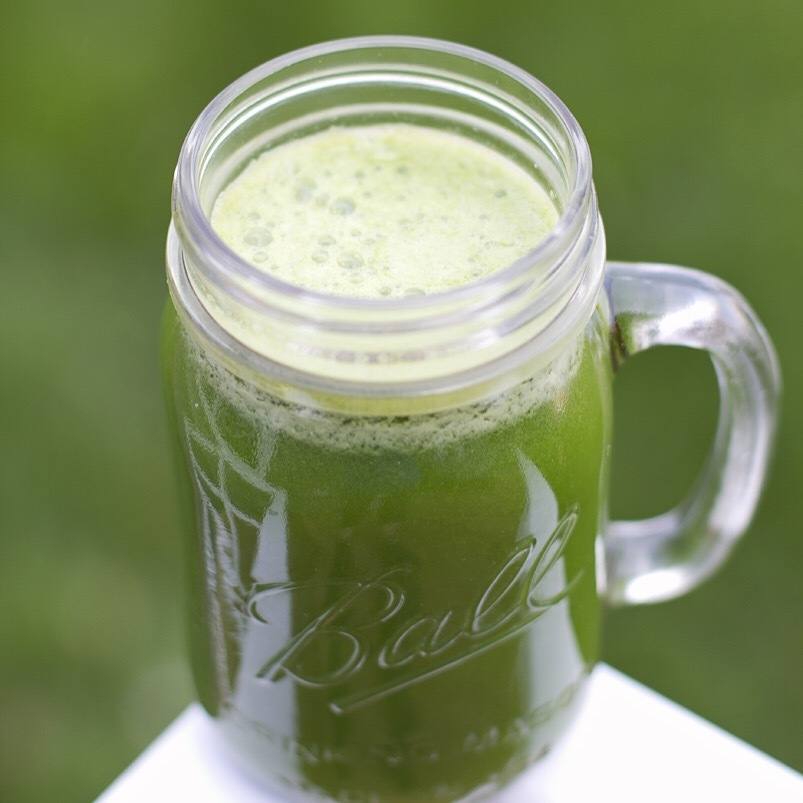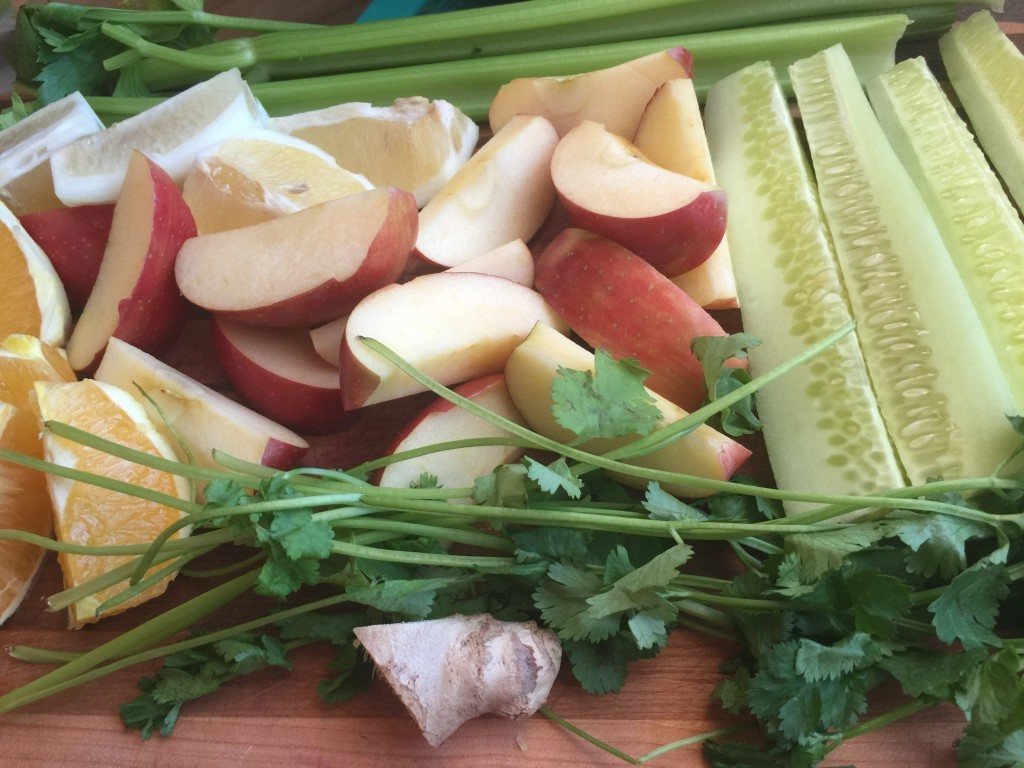I have been juicing fresh vegetables on a regular basis for 4 years now. I compiled these tips after having only done it for a few months, so I added a couple to update my thoughts a bit!
1. Buy organic when you can, especially when buying celery, leafy greens, herbs, and apples.
2. Wash all produce with a high-quality, all-natural fruit and vegetable rinse. This ensures that pesticides and other chemicals are removed, and it also keeps your produce fresh longer in the fridge. You would be amazed at the dirt I rinse out of the bucket after washing all of my produce—yuck.
3. Wash your produce all at once when you get home from the store. It will all be washed and ready to go when you need it for juicing, or just for munching. This saves me lots of time, especially in the morning.
4. If using a masticating juicer, some preparation of the produce is required. I assemble the juicer the night before so it’s ready to go. In the morning, I take out my produce and begin cutting up whatever I need to (apples, oranges, lemons, carrots if they’re too big, cucumbers, etc.). While I’m cutting, I am also juicing. I throw in a carrot and while it’s juicing I cut my apple. It saves a lot of time. It takes me about 20 minutes each morning to gather everything, prepare it, and make enough juice for my husband and I.
5. Always alternate leafy greens with solid veggies, such as carrots or celery. This helps prevent clogs in your auger and keeps things moving along.
6. If juicing beets, remove the skins. I use a vegetable peeler to remove them. Don’t discard the beet greens; they can be juiced as well.
7. Cucumbers and citrus should also be peeled. Because of their waxy coating, it is hard to remove all chemicals on the surface of cucumbers. Oranges can be peeled with a vegetable peeler to remove the outer skin, but leaving the white pith (or just cut them and take the skins off like you normally would to eat it). Most other produce can be juiced with the skin intact.
8. Experiment with different combinations. It took me a while to get used to the taste of drinking vegetables, but now I really enjoy it. Add in a lemon or an orange to perk things up. Add some ginger or cilantro for a fresh flavor. The possibilities are endless. You can see some of my recipes for juice here and here.
9. Be cautious when juicing fruit. Fruit juices have high sugar content, and that sugar (in juice form) is instantly absorbed, creating a spike in blood sugar levels. Along with that spike, comes a crash. Fruits are easy to digest, and should be eaten whole most of the time. It’s fine to throw in an apple or piece of citrus fruit with your vegetable juice, but avoid drinking straight fruit juice on a regular basis. If you want a treat, drink fresh fruit juice alongside your meal. This way, the food will help slow down the absorption of sugar into your bloodstream.
10. Like any budget-conscious mom will tell you, plan ahead when grocery shopping. Look at what produce is on sale, and stock up if you are going to be juicing a lot. Making a plan of what you want to juice before you go to the store will prevent you from standing dumb-founded in front of all the produce, with no idea where to start. When doing our fast, I looked at the weekly ads on Tuesday night. If cucumbers were on sale that day, but wouldn’t be on Wednesday morning, I ran to the store to stock up. (Note: we did our first juice fast while actually living near a store, now I have to really plan ahead to get my produce)
11. Some produce will keep longer in the fridge so you can buy enough for a week at a time: apples, oranges, lemons, carrots, beets, celery, etc. Try to buy leafy greens, cucumbers, tomatoes, and herbs fresh every few days.
12. Have a pitcher or glass Mason jar handy if juicing for more than one person. I found a great glass pitcher with an air-tight lid at Wal-Mart for a few dollars. I pour the juice into it as my one-serving container (what the juice goes into from the juicer) gets full, and can even keep it in the fridge for 30 minutes or so if I need to.
Juicing continues to be one of the things where I notice the biggest difference in my health. When I am not juicing as much, I can tell. It is such a great source of natural energy and I love knowing I am getting in all of that extra nutrition, no matter what the day might bring.
Cold-pressed juices are popping up all over the place now and I make my own for a fraction of the price they charge, and have paid for my juicer over and over again!








Hi Kelsey.
I've been reading your blog and loving it! I actually bought a juicer the other day and have juiced once a day for the past 3 days. It tastes better than I thought, and I'm totally surprised how full I feel after. I think I'm going to do a cleanse after I'm done nursing. Anyways, I think you should post your favorite combos for juicing!
Thanks
Abby
I see that you combine fruits and veggies in your juice. I’ve read that ideally apples are the only fruit that should ever be combined with veggies for digestive purposes. What do you know about that? Along the same lines, I’ve also heard you should never eat fruit (and especially melons) with other foods, again because the digestive process is so different it will often just ferment in your stomach if eaten with other harder-to-digest foods. I’ve been following you on instagram for awhile and have noticed that you often combine melons and fruits with your meal. What’s your reasoning behind that and have you never had any issues digesting that combination?
This is SUCH a great question. As for the juice, I actually haven’t read that but know to keep fruits to a minimum for the sugar factor. You definitely don’t want it to be fruit heavy. It is a school of thought that combining fruit with your meal will lead to digestive upset (known as food pairing, putting certain foods together for optimal digestion). And I try not to eat fruit while I am eating other foods, only after I have eaten. I add it to my plate for photography purposes, but don’t take bites of fruit as I am eating eggs . . . if that makes sense! It can cause the fruit to ferment and lead to symptoms that some people attribute to other things, like gluten intolerance! The simple removal of fruit from a meal can take away that pain for some. I try to keep them separate, our fruit is always used more as a dessert. It might not help everyone because we are all so individual, but it’s made a difference for me. Even that small part of not eating it WITH other things. Some might need to remove it for 30-60 minutes after a meal to see if it has an effect.
Thanks so much for your comment!